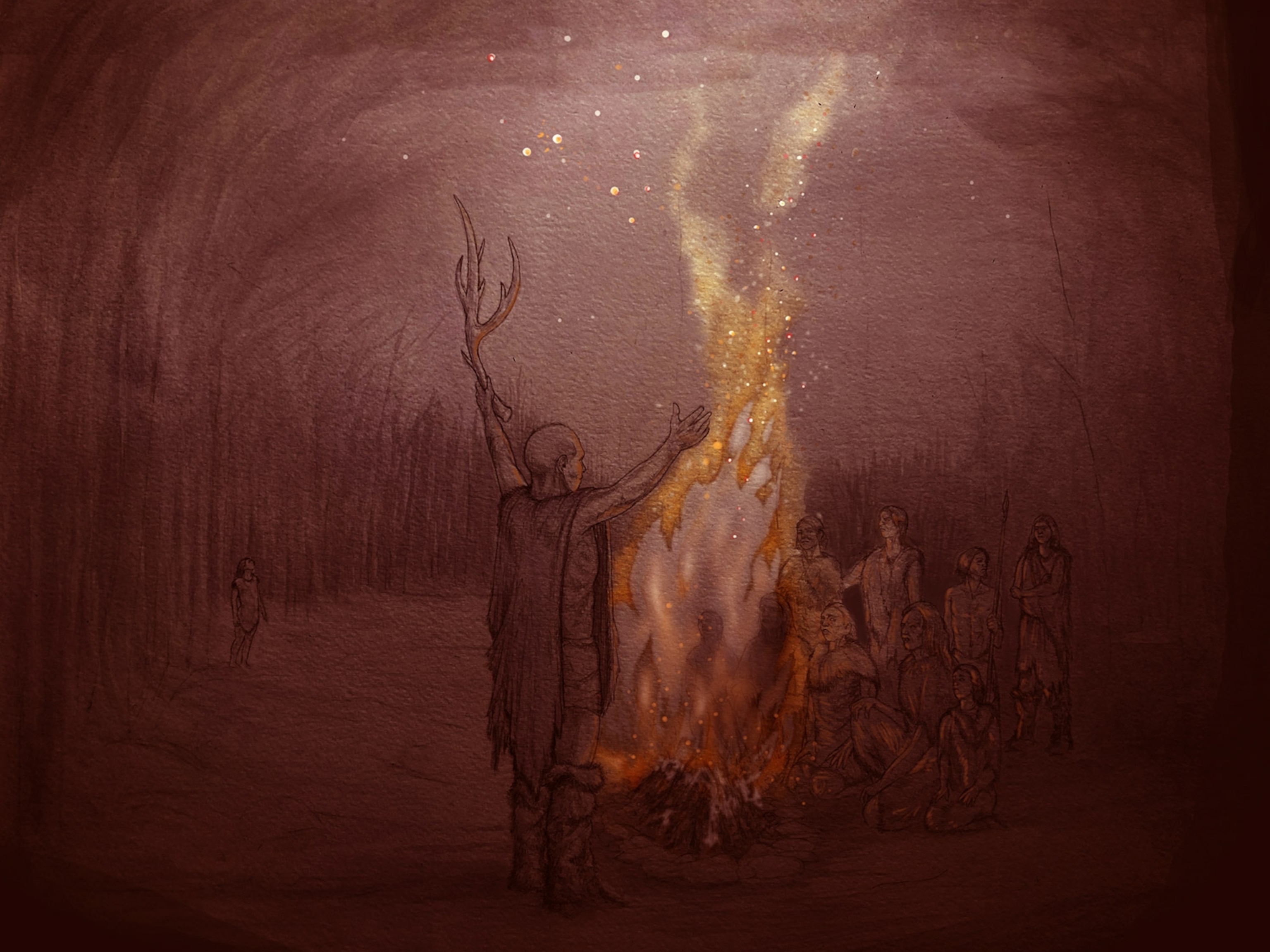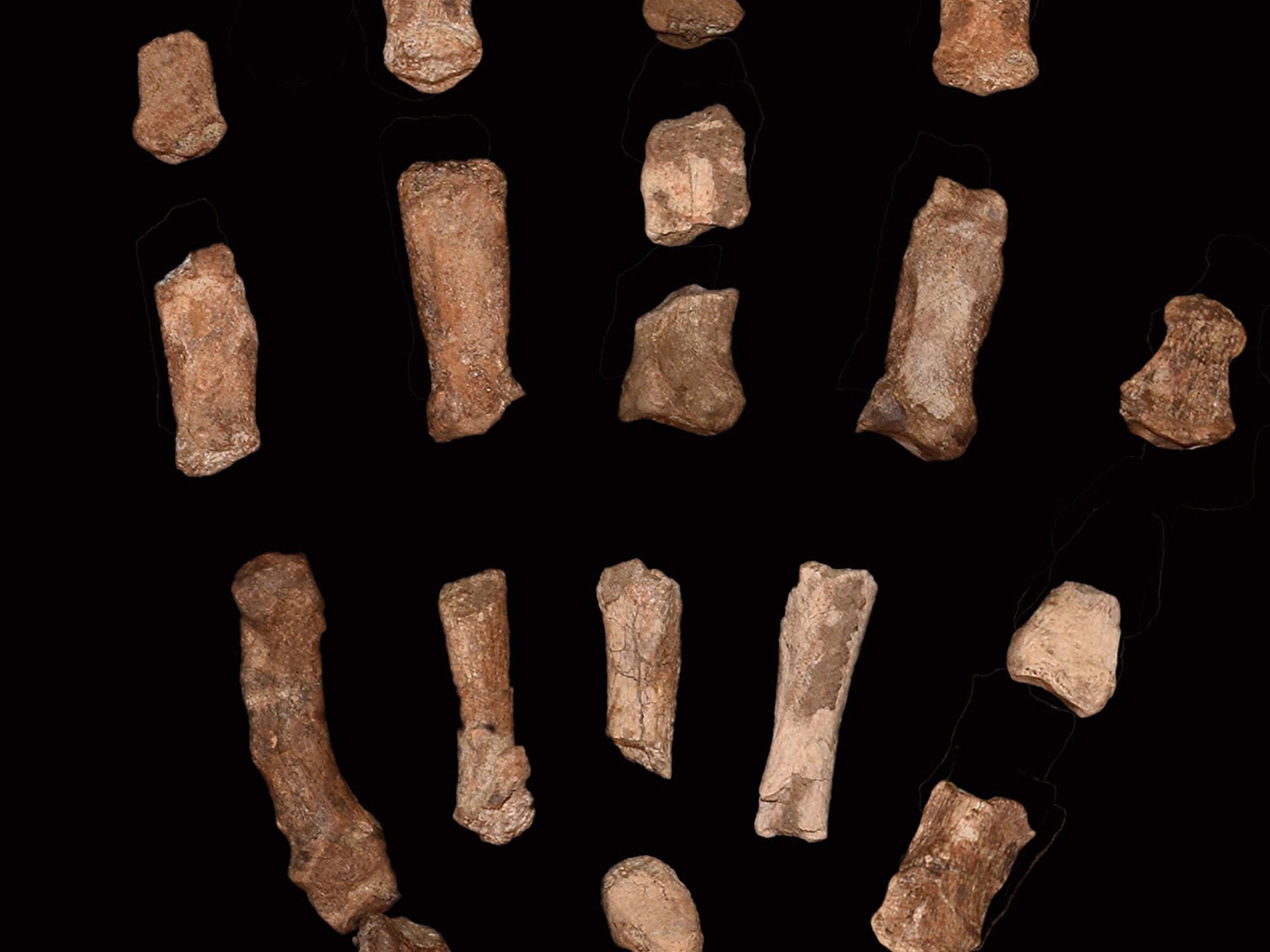
Puzzling skull discovery may point to previously unknown human ancestor
The remains were found with tools often associated with modern humans, but have features of archaic hominins who had been around for much longer.
When they first laid eyes on the fragmentary remains of the dun-colored skull—part of a flat and low brain case, a nearly complete, chinless lower jaw, and one lonely tooth—the Israeli paleoanthropologists immediately realized it was not one of… us.
Unlike we Homo sapiens, who have tall, rounded skulls encasing our large brains, the remains before the researchers had features typical of older species of Homo that likely arrived in the Middle East around 450,000 years ago, a quarter-million years before Homo sapiens showed up. Meanwhile, the tooth seemed very similar to those found in local hominin populations dated to 400,000 years ago, as well as those of Neanderthals.
Surprisingly, this unusual skull with some rather archaic features turns out to be no more than 120,000 to 140,000 years old, a time when Homo sapiens was already around. It was also surrounded by advanced stone tools that are usually assumed to be made by bigger-brained Homo sapiens or possibly Neanderthals. To paleoanthropologists, the shared technology suggests different kinds of Homo are likely to have met.
This complicates the picture of an already confusing period stretching from around 770,000 to 126,000 years ago: the Middle Pleistocene. At the time, Africa and Eurasia were populated by a variety of so-called archaic hominins chronologically bookmarked between the earlier, more primitive Homo erectus and the later, more advanced Neanderthals and Homo sapiens. Hominin remains from the Middle Pleistocene, which often display a mosaic of primitive and more modern features, were often categorized as Homo heidelbergensis, a “catch-all” species some scientists now feel has been stretched beyond its limits.
But the researchers hope that the new discovery may also provide some new clarity. In two papers published today in the journal Science, researchers explore the evidence this discovery provides to determine where the remains fit in the hominin family tree, and how they might be connected to other populations.
“We knew that Homo sapiens was in this region around this time,” says Hila May, a paleoanthropologist at Tel Aviv University and one of the papers’ several authors, “but until now we didn’t have any evidence that other kinds of Homo were still around during this period.”
“The implications are astonishing,” says Tel Aviv University anthropologist Israel Hershkovitz, a National Geographic Explorer who was lead author on the Science paper describing the bones. “Two Homo groups coexisted in the Levant for almost 100,000 years, exchanging knowledge and genes.”
Impressive skills
The discovery comes from a site called Nesher Ramla, located in a quarry in central Israel. After bulldozers accidentally revealed a treasure trove of prehistoric stone tools in the quarry in 2010, archaeologists spent nearly a year excavating evidence for prodigious hunting activity between 140,000 and 100,000 years ago: Along with tens of thousands of stone tools were the remains of a variety of animals, including tortoises, gazelles, and deer, as well as evidence of butchering and fire.
Researchers consider the tools found throughout Nesher Ramla as quite advanced. Originally, our hominin ancestors fashioned rough stones into sharp hand axes by knapping flakes from the edges until the stone itself could be used for cutting and digging. Later on, as tool makers discovered that discarded flakes could also be used as finer knives, scrapers, or spear points, they developed new methods to knap exactly the flakes they liked from a good flint stone.
The particular knapping method used by hominins at Nesher Ramla is known as “centripetal Levallois”. Evidence of its use in the region is often found with remains of Homo sapiens, stretching from around 140,000 to 80,000 years ago. More recently, Neanderthals in Europe appear to have used it as well.
Yossi Zaidner, an archaeologist at the Hebrew University of Jerusalem, first author of the paper describing the tools and also a National Geographic Explorer, attests to the complexity of the tool making techniques seen at Nesher Ramla. “I’ve done some stone knapping myself. I can make simple stone tools, but certainly not Levallois points, as these require a lot of training. So I am still at the Homo erectus level,” he jokes.
But how to explain the presence of a hominin with a small braincase more similar to that of archaic species of Homo yet who crafted such advanced tools? Could some of the stone tools found at Nesher Ramla have been left there by Homo sapiens, allowing its distant, archaic cousin to figure out how to use and produce these tools?
Zaidner thinks that theory is unlikely to be true. First of all, he points out, the skull fragments were found at the bottom of the deposit, which was more than 25 feet deep, strongly suggesting that the newly discovered Nesher Ramla hominin arrived in this particular spot before Homo sapiens did. More importantly, he believes the centripetal Levallois method did not originate in the Middle East but rather in Africa, and some of the tools found there may have been made by archaic species rather than Homo sapiens. So it is equally possible, Zaidner says, that Homo sapiens learned the specific tool knapping technology from archaic hominins.
This would have required some contemporaneous interaction between more primitive and more modern hominin species, says archaeologist Alison Brooks of George Washington University, who was not involved in the study.
“The complexity of the technique is difficult to master without considerable training, best informed by visual and oral teaching,” says Brooks, who also thinks the technology is likely to have originated in Africa.
Zaidner agrees, believing that hominins who mastered these skills may have migrated into other hominin groups, passing on the technique by demonstration, spreading it across Europe and beyond.
No New Species, Please
When the researchers analyzed the characteristics of the skull remains to try and see where in the hominin family tree it might fit, they ran into confusion. The specimen did not seem to match all that well with any particular Homo species, not even the “catch-all” Homo heidelbergensis.
Some scientists may therefore be tempted to claim the Nesher Ramla skull belongs to a new species, says Hershkovitz. But he doesn’t believe that would be helpful.
“We think it’s inaccurate, even inappropriate, to pick up such an isolated specimen and name it a new species. We do have a unique combination of features here.” But that appears to be common in hominins from the Middle Pleistocene, he argues. “To us, it suggests the presence of several types, not species.”
The unstable climate around the Middle Pleistocene, with periods of severe cold alternating with milder weather, caused populations in Europe to contract and expand. When hominin groups grew small and isolated due to harsh conditions, their bodies and cultures evolved their own peculiar characteristics. Then when climatic conditions improved, those populations would expand, meet, and mix with other hominin groups, exchanging culture and genes. This, Hershkovitz and colleagues argue, gave rise to the mosaic of features seen in hominin populations of the Middle Pleistocene.
The distinctive group of people that the owner of the skull at Nesher Ramla belonged to may have played an important role in this story, the scientists believe. Since conditions in the Middle East at the time were more stable than those farther north, regional populations would have been larger, possibly repopulating northern regions whenever the ice caps receded.
“We think the Nesher Ramla Homo were the source population for many of the groups that are appearing in Europe later,” says Rachel Sarig, a medical anthropologist at Tel Aviv University and paper author. The Neanderthal-like teeth of the Nesher Ramla hominin may be an indication of this.
A genetic analysis of the Nesher Ramla hominin and its family relations will probably not be possible, May says. “In an open-air site in a warm environment such as this one, DNA degrades much faster than it does in caves or colder climates,” she explains.
Nevertheless, the timing and location of the fossil is tantalizing, and its well-preserved features help to make sense of other finds from the region that have been difficult to categorize until now. This includes hominin teeth found in Qesem cave, about 20 miles to the north, which are very similar to the one found in Nesher Ramla, Sarig says, but also much older, dating to around 400,000 years ago.
If this means hominins of the Nesher Ramla type were already present at that time, they might also have contributed at least some of their genes to a mysterious group of hominins found in Sima de los Huesos (“Pit of Bones”) in northern Spain. These also have very similar teeth, Herskovitz says, and are often considered pre-Neanderthal.
An earlier genetic analysis of the remains from Sima de los Huesos has revealed some puzzling relatedness to the Siberian Denisovans. Perhaps they inherited common features via the Nesher Ramla population, which may have had a chance to mingle with the Denisovans’ ancestors when they passed through the Middle East on their way into Asia. “We think early members of the Nesher Ramla group may have started migrating into Europe as early as 400,000 years ago,” says Hershkovitz.
Paleoanthropologist Michael Petraglia from the Max Planck Institute for the Science of Human History agrees that these findings support the emerging view that “we can no longer envision a simple unilinear model of our evolution. There were many expansions, contractions, and extinctions.”
Shara Bailey, a paleoanthropologist at New York University who was not involved in this study, agrees that the Nesher Ramla fossils show “a combination of archaic and distinctly Neanderthal features,” but adds that “it is always difficult to know if a single fossil is indicative of what the population looked like.”
In any case, she says, “I think we are all—or most of us—starting to accept a much more muddied picture of human evolution during the Middle Pleistocene, a view that is much changed from that of a few decades ago."







